Work Health and Safety (WHS) Policy for Desklib
VerifiedAdded on 2023/06/15
|13
|3394
|233
AI Summary
This policy outlines Desklib's commitment to ensuring a safe and healthy workplace for all employees. It includes our legal duties as an employer and our approach to WHS. We aim to provide a workplace that is free from hazards and risks, and we encourage all employees to take an active role in maintaining a safe and healthy environment. This policy applies to all employees, contractors, and visitors to our workplace.
Contribute Materials
Your contribution can guide someone’s learning journey. Share your
documents today.
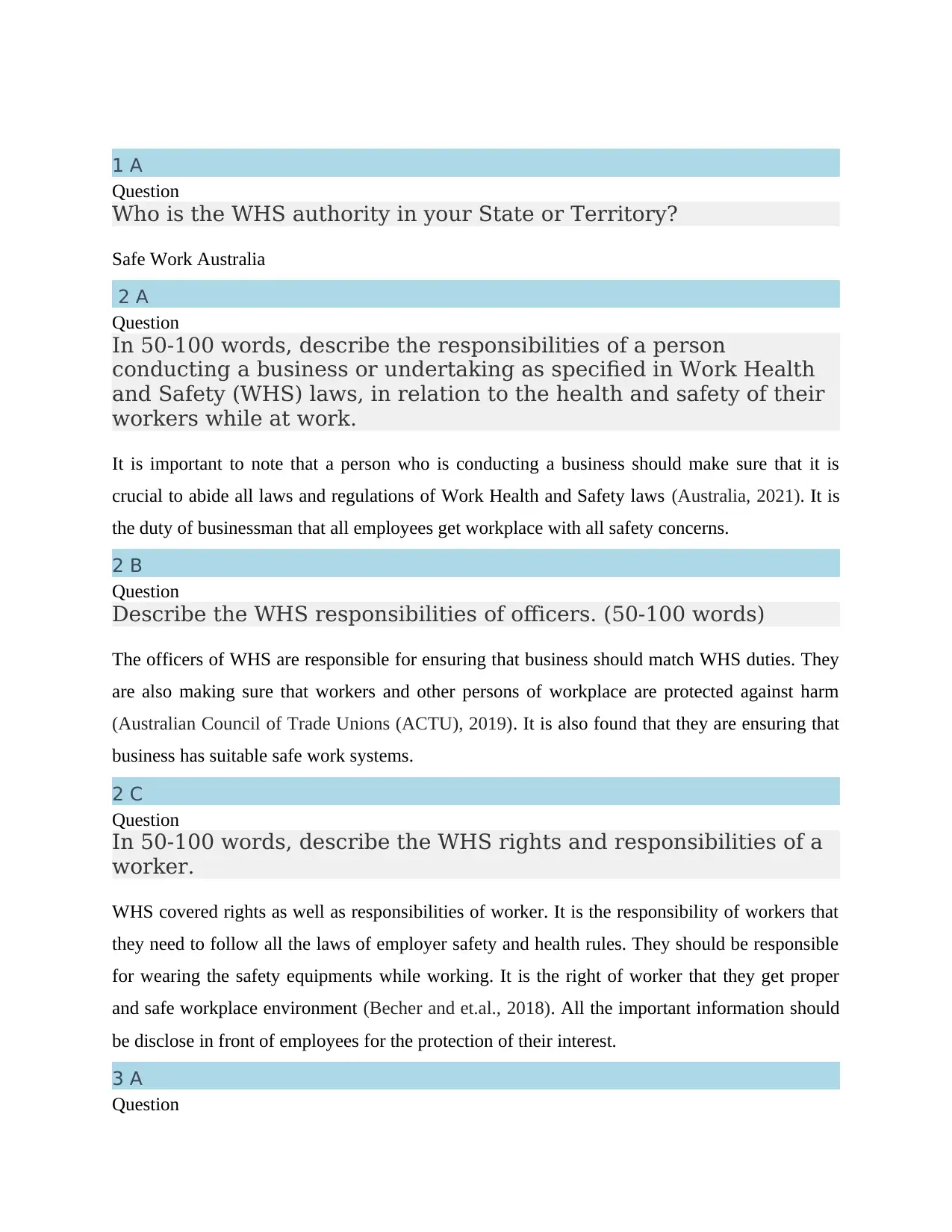
1 A
Question
Who is the WHS authority in your State or Territory?
Safe Work Australia
2 A
Question
In 50-100 words, describe the responsibilities of a person
conducting a business or undertaking as specified in Work Health
and Safety (WHS) laws, in relation to the health and safety of their
workers while at work.
It is important to note that a person who is conducting a business should make sure that it is
crucial to abide all laws and regulations of Work Health and Safety laws (Australia, 2021). It is
the duty of businessman that all employees get workplace with all safety concerns.
2 B
Question
Describe the WHS responsibilities of officers. (50-100 words)
The officers of WHS are responsible for ensuring that business should match WHS duties. They
are also making sure that workers and other persons of workplace are protected against harm
(Australian Council of Trade Unions (ACTU), 2019). It is also found that they are ensuring that
business has suitable safe work systems.
2 C
Question
In 50-100 words, describe the WHS rights and responsibilities of a
worker.
WHS covered rights as well as responsibilities of worker. It is the responsibility of workers that
they need to follow all the laws of employer safety and health rules. They should be responsible
for wearing the safety equipments while working. It is the right of worker that they get proper
and safe workplace environment (Becher and et.al., 2018). All the important information should
be disclose in front of employees for the protection of their interest.
3 A
Question
Question
Who is the WHS authority in your State or Territory?
Safe Work Australia
2 A
Question
In 50-100 words, describe the responsibilities of a person
conducting a business or undertaking as specified in Work Health
and Safety (WHS) laws, in relation to the health and safety of their
workers while at work.
It is important to note that a person who is conducting a business should make sure that it is
crucial to abide all laws and regulations of Work Health and Safety laws (Australia, 2021). It is
the duty of businessman that all employees get workplace with all safety concerns.
2 B
Question
Describe the WHS responsibilities of officers. (50-100 words)
The officers of WHS are responsible for ensuring that business should match WHS duties. They
are also making sure that workers and other persons of workplace are protected against harm
(Australian Council of Trade Unions (ACTU), 2019). It is also found that they are ensuring that
business has suitable safe work systems.
2 C
Question
In 50-100 words, describe the WHS rights and responsibilities of a
worker.
WHS covered rights as well as responsibilities of worker. It is the responsibility of workers that
they need to follow all the laws of employer safety and health rules. They should be responsible
for wearing the safety equipments while working. It is the right of worker that they get proper
and safe workplace environment (Becher and et.al., 2018). All the important information should
be disclose in front of employees for the protection of their interest.
3 A
Question
Secure Best Marks with AI Grader
Need help grading? Try our AI Grader for instant feedback on your assignments.
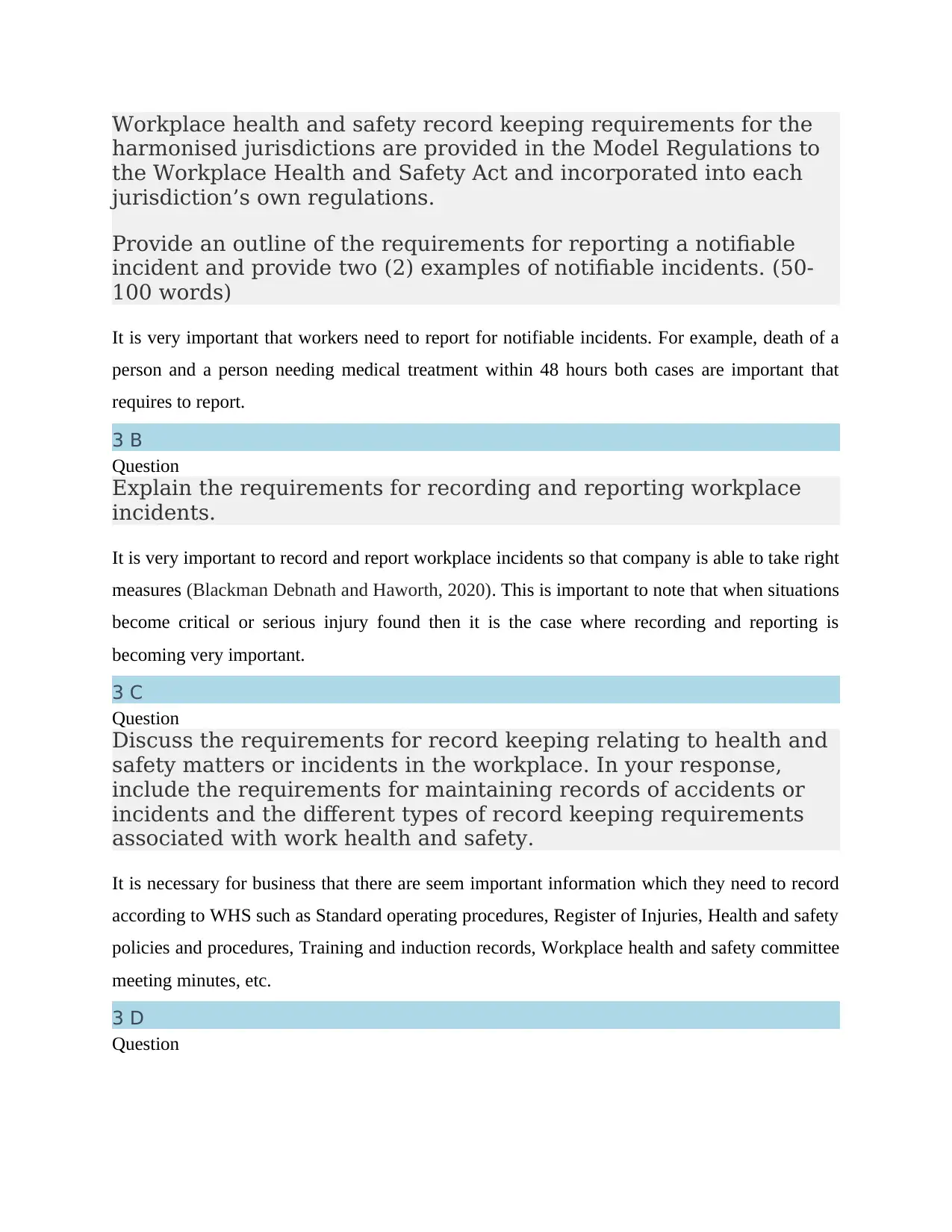
Workplace health and safety record keeping requirements for the
harmonised jurisdictions are provided in the Model Regulations to
the Workplace Health and Safety Act and incorporated into each
jurisdiction’s own regulations.
Provide an outline of the requirements for reporting a notifiable
incident and provide two (2) examples of notifiable incidents. (50-
100 words)
It is very important that workers need to report for notifiable incidents. For example, death of a
person and a person needing medical treatment within 48 hours both cases are important that
requires to report.
3 B
Question
Explain the requirements for recording and reporting workplace
incidents.
It is very important to record and report workplace incidents so that company is able to take right
measures (Blackman Debnath and Haworth, 2020). This is important to note that when situations
become critical or serious injury found then it is the case where recording and reporting is
becoming very important.
3 C
Question
Discuss the requirements for record keeping relating to health and
safety matters or incidents in the workplace. In your response,
include the requirements for maintaining records of accidents or
incidents and the different types of record keeping requirements
associated with work health and safety.
It is necessary for business that there are seem important information which they need to record
according to WHS such as Standard operating procedures, Register of Injuries, Health and safety
policies and procedures, Training and induction records, Workplace health and safety committee
meeting minutes, etc.
3 D
Question
harmonised jurisdictions are provided in the Model Regulations to
the Workplace Health and Safety Act and incorporated into each
jurisdiction’s own regulations.
Provide an outline of the requirements for reporting a notifiable
incident and provide two (2) examples of notifiable incidents. (50-
100 words)
It is very important that workers need to report for notifiable incidents. For example, death of a
person and a person needing medical treatment within 48 hours both cases are important that
requires to report.
3 B
Question
Explain the requirements for recording and reporting workplace
incidents.
It is very important to record and report workplace incidents so that company is able to take right
measures (Blackman Debnath and Haworth, 2020). This is important to note that when situations
become critical or serious injury found then it is the case where recording and reporting is
becoming very important.
3 C
Question
Discuss the requirements for record keeping relating to health and
safety matters or incidents in the workplace. In your response,
include the requirements for maintaining records of accidents or
incidents and the different types of record keeping requirements
associated with work health and safety.
It is necessary for business that there are seem important information which they need to record
according to WHS such as Standard operating procedures, Register of Injuries, Health and safety
policies and procedures, Training and induction records, Workplace health and safety committee
meeting minutes, etc.
3 D
Question
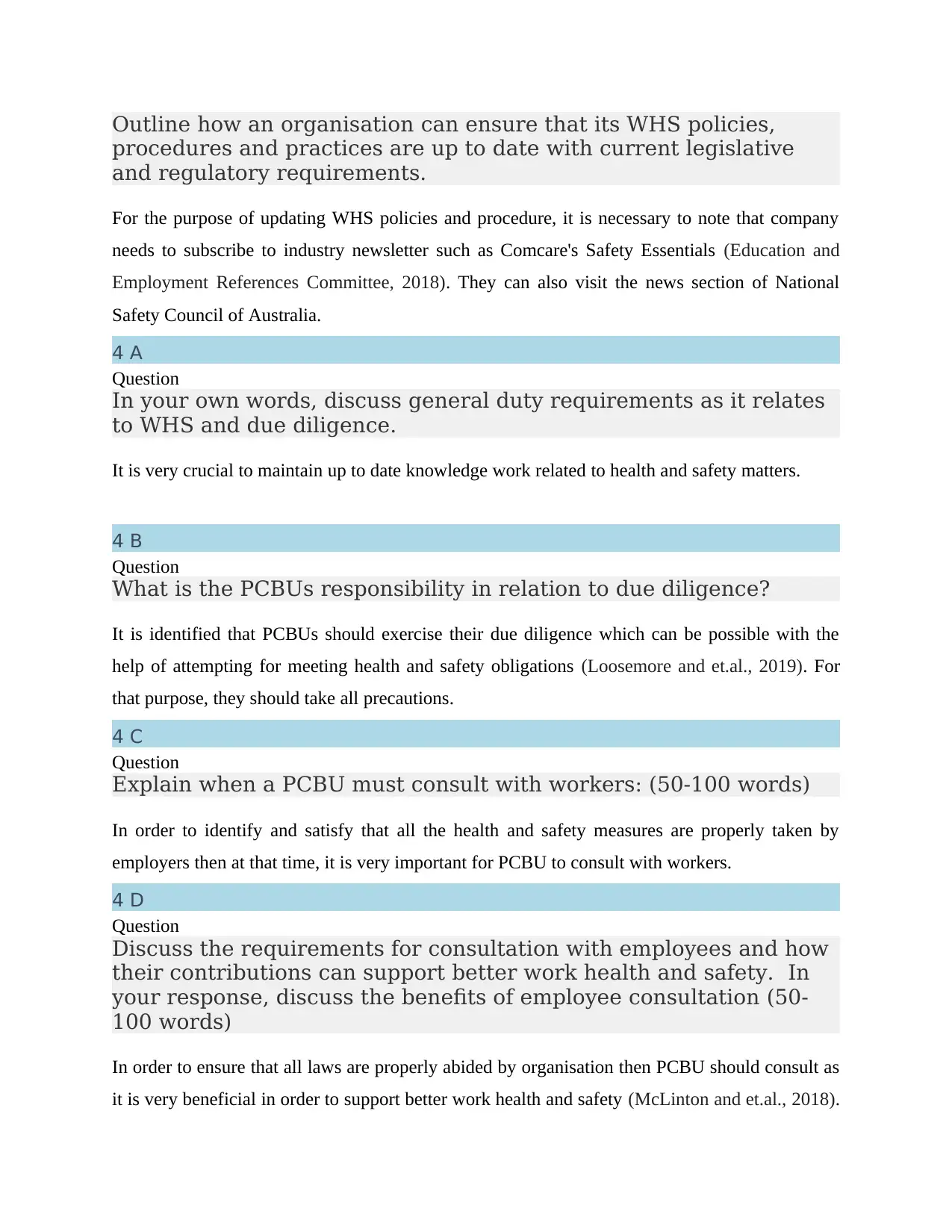
Outline how an organisation can ensure that its WHS policies,
procedures and practices are up to date with current legislative
and regulatory requirements.
For the purpose of updating WHS policies and procedure, it is necessary to note that company
needs to subscribe to industry newsletter such as Comcare's Safety Essentials (Education and
Employment References Committee, 2018). They can also visit the news section of National
Safety Council of Australia.
4 A
Question
In your own words, discuss general duty requirements as it relates
to WHS and due diligence.
It is very crucial to maintain up to date knowledge work related to health and safety matters.
4 B
Question
What is the PCBUs responsibility in relation to due diligence?
It is identified that PCBUs should exercise their due diligence which can be possible with the
help of attempting for meeting health and safety obligations (Loosemore and et.al., 2019). For
that purpose, they should take all precautions.
4 C
Question
Explain when a PCBU must consult with workers: (50-100 words)
In order to identify and satisfy that all the health and safety measures are properly taken by
employers then at that time, it is very important for PCBU to consult with workers.
4 D
Question
Discuss the requirements for consultation with employees and how
their contributions can support better work health and safety. In
your response, discuss the benefits of employee consultation (50-
100 words)
In order to ensure that all laws are properly abided by organisation then PCBU should consult as
it is very beneficial in order to support better work health and safety (McLinton and et.al., 2018).
procedures and practices are up to date with current legislative
and regulatory requirements.
For the purpose of updating WHS policies and procedure, it is necessary to note that company
needs to subscribe to industry newsletter such as Comcare's Safety Essentials (Education and
Employment References Committee, 2018). They can also visit the news section of National
Safety Council of Australia.
4 A
Question
In your own words, discuss general duty requirements as it relates
to WHS and due diligence.
It is very crucial to maintain up to date knowledge work related to health and safety matters.
4 B
Question
What is the PCBUs responsibility in relation to due diligence?
It is identified that PCBUs should exercise their due diligence which can be possible with the
help of attempting for meeting health and safety obligations (Loosemore and et.al., 2019). For
that purpose, they should take all precautions.
4 C
Question
Explain when a PCBU must consult with workers: (50-100 words)
In order to identify and satisfy that all the health and safety measures are properly taken by
employers then at that time, it is very important for PCBU to consult with workers.
4 D
Question
Discuss the requirements for consultation with employees and how
their contributions can support better work health and safety. In
your response, discuss the benefits of employee consultation (50-
100 words)
In order to ensure that all laws are properly abided by organisation then PCBU should consult as
it is very beneficial in order to support better work health and safety (McLinton and et.al., 2018).

Employees will feel confident and respectful that they are working in the place where
employees’ consultation is crucial.
5 A
Question
Discuss the Code of Practice relating to manual tasks and its
relationship with the WHS Act.
Code of practices in WHS Act is providing detail information that how an organisation is
achieving their business standards. In manual tasks, code of practices is concerning about the
management of risks associated with hazardous manual tasks.
5 B
Question
What are four (4) injuries that may be sustained from hazardous
manual tasks and from a generic perspective, what are three (3)
main causes of these injuries?
Four injuries are including back injuries, sprains and strains, hernias and chronic pain (Provan
and Pryor, 2019). The main causes of these injuries are falling whilst carrying a load, dropping a
load, and incorrect or unsafe use of a handling equipment.
5 C
Question
What are the manual tasks that put workers at risk of injury in the
community care sectors and how can these injuries be avoided or
minimised? (50-100 words)
Manual tasks are including lack of physical space, Heavy physical work, etc. In order to
minimise injuries, it is crucial make the load lighter and smaller, modification of workplaces, etc.
6 A
Question
Explain the hierarchy of control and the associated strategies for
controlling risks.
It is defined as the system which is used for the purpose of controlling risk in workplaces.
Strategies for controlling risk are including isolation, substitution and engineering controls.
6 B
Question
employees’ consultation is crucial.
5 A
Question
Discuss the Code of Practice relating to manual tasks and its
relationship with the WHS Act.
Code of practices in WHS Act is providing detail information that how an organisation is
achieving their business standards. In manual tasks, code of practices is concerning about the
management of risks associated with hazardous manual tasks.
5 B
Question
What are four (4) injuries that may be sustained from hazardous
manual tasks and from a generic perspective, what are three (3)
main causes of these injuries?
Four injuries are including back injuries, sprains and strains, hernias and chronic pain (Provan
and Pryor, 2019). The main causes of these injuries are falling whilst carrying a load, dropping a
load, and incorrect or unsafe use of a handling equipment.
5 C
Question
What are the manual tasks that put workers at risk of injury in the
community care sectors and how can these injuries be avoided or
minimised? (50-100 words)
Manual tasks are including lack of physical space, Heavy physical work, etc. In order to
minimise injuries, it is crucial make the load lighter and smaller, modification of workplaces, etc.
6 A
Question
Explain the hierarchy of control and the associated strategies for
controlling risks.
It is defined as the system which is used for the purpose of controlling risk in workplaces.
Strategies for controlling risk are including isolation, substitution and engineering controls.
6 B
Question
Secure Best Marks with AI Grader
Need help grading? Try our AI Grader for instant feedback on your assignments.
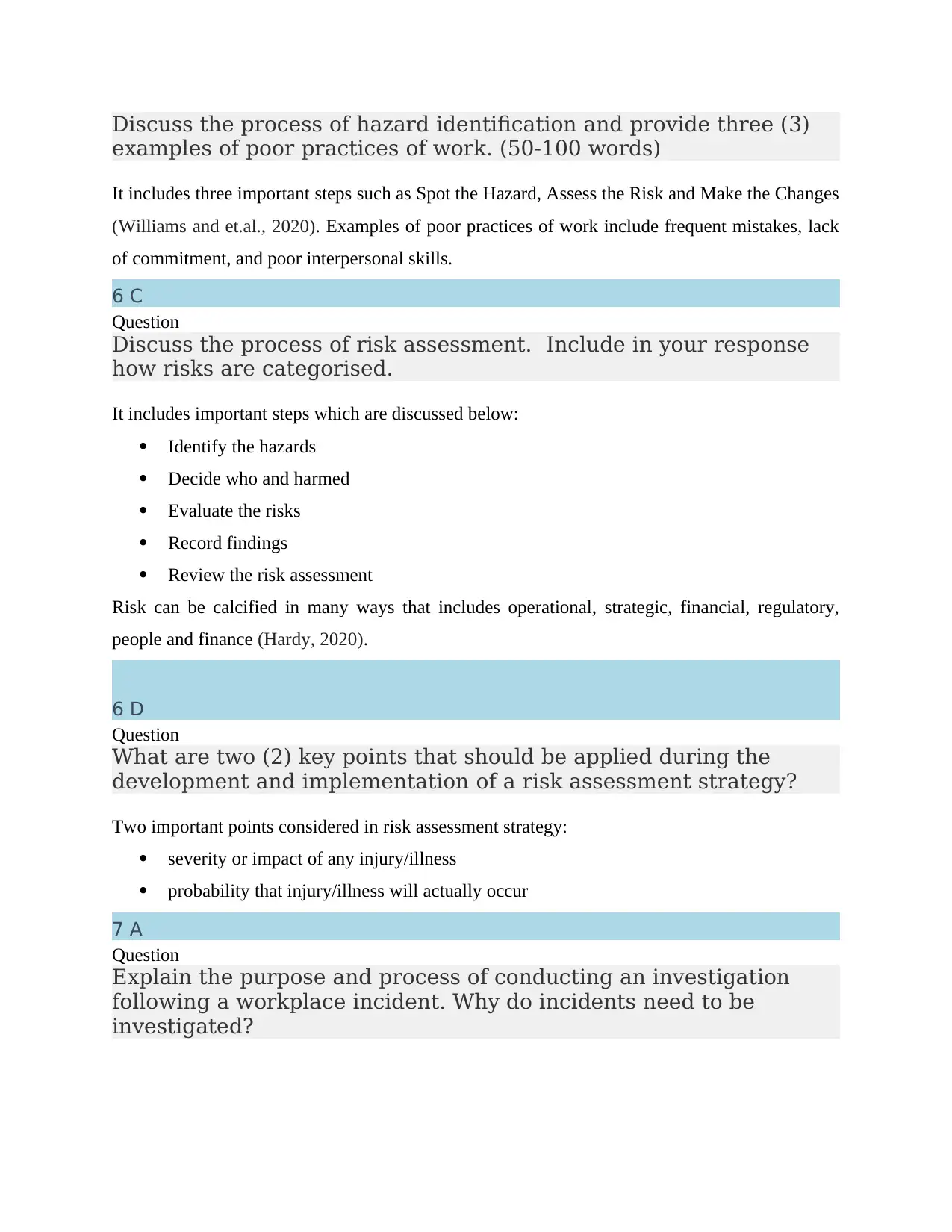
Discuss the process of hazard identification and provide three (3)
examples of poor practices of work. (50-100 words)
It includes three important steps such as Spot the Hazard, Assess the Risk and Make the Changes
(Williams and et.al., 2020). Examples of poor practices of work include frequent mistakes, lack
of commitment, and poor interpersonal skills.
6 C
Question
Discuss the process of risk assessment. Include in your response
how risks are categorised.
It includes important steps which are discussed below:
Identify the hazards
Decide who and harmed
Evaluate the risks
Record findings
Review the risk assessment
Risk can be calcified in many ways that includes operational, strategic, financial, regulatory,
people and finance (Hardy, 2020).
6 D
Question
What are two (2) key points that should be applied during the
development and implementation of a risk assessment strategy?
Two important points considered in risk assessment strategy:
severity or impact of any injury/illness
probability that injury/illness will actually occur
7 A
Question
Explain the purpose and process of conducting an investigation
following a workplace incident. Why do incidents need to be
investigated?
examples of poor practices of work. (50-100 words)
It includes three important steps such as Spot the Hazard, Assess the Risk and Make the Changes
(Williams and et.al., 2020). Examples of poor practices of work include frequent mistakes, lack
of commitment, and poor interpersonal skills.
6 C
Question
Discuss the process of risk assessment. Include in your response
how risks are categorised.
It includes important steps which are discussed below:
Identify the hazards
Decide who and harmed
Evaluate the risks
Record findings
Review the risk assessment
Risk can be calcified in many ways that includes operational, strategic, financial, regulatory,
people and finance (Hardy, 2020).
6 D
Question
What are two (2) key points that should be applied during the
development and implementation of a risk assessment strategy?
Two important points considered in risk assessment strategy:
severity or impact of any injury/illness
probability that injury/illness will actually occur
7 A
Question
Explain the purpose and process of conducting an investigation
following a workplace incident. Why do incidents need to be
investigated?

In order to find the cause of incidents is one of the main purposes of conducting investigations
(Woolley and et.al., 2020). The workplace incident should be investigated for ascertaining causal
and contributing factors of an incident.
7 B
Question
Describe the reason/s for using PPE.
In order to minimise exposures of hazardous, it is necessary to use PPE which can be become a
cause of serious workplace injuries.
7 C
Question
Describe four (4) items of personal protective equipment and their
purpose.
Four items include gloves, shoes, safety glasses, and hard hats (Frino and Sarina, 2020). In order
to protect hands, eyes, feet and head, these equipments are using.
7 D
Question
In terms of the PPE being fit for purpose, what should the use of
PPE ensure and how should PPE be used and maintained.
It is necessary to keep safe place PPE in order to use and maintain PPE effectiveness (Gooding,
2019).
8 A
Question
What are four (4) ways to assist in the prevention of infection
spreading between workers and clients?
Four ways include:
Staying at home
Immunise against infectious diseases
Wash and dry hands
Proper ventilation of home
8 B
Question
(Woolley and et.al., 2020). The workplace incident should be investigated for ascertaining causal
and contributing factors of an incident.
7 B
Question
Describe the reason/s for using PPE.
In order to minimise exposures of hazardous, it is necessary to use PPE which can be become a
cause of serious workplace injuries.
7 C
Question
Describe four (4) items of personal protective equipment and their
purpose.
Four items include gloves, shoes, safety glasses, and hard hats (Frino and Sarina, 2020). In order
to protect hands, eyes, feet and head, these equipments are using.
7 D
Question
In terms of the PPE being fit for purpose, what should the use of
PPE ensure and how should PPE be used and maintained.
It is necessary to keep safe place PPE in order to use and maintain PPE effectiveness (Gooding,
2019).
8 A
Question
What are four (4) ways to assist in the prevention of infection
spreading between workers and clients?
Four ways include:
Staying at home
Immunise against infectious diseases
Wash and dry hands
Proper ventilation of home
8 B
Question
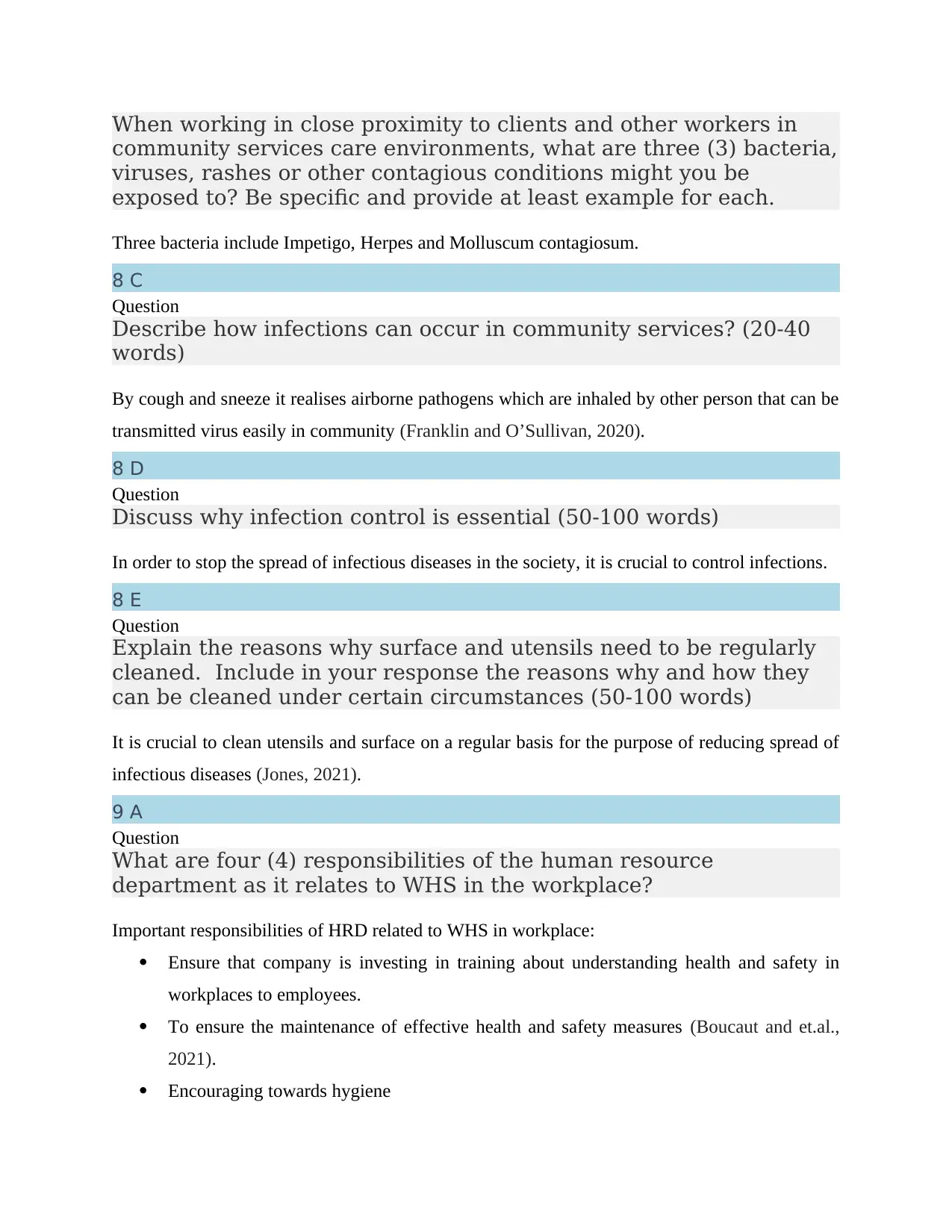
When working in close proximity to clients and other workers in
community services care environments, what are three (3) bacteria,
viruses, rashes or other contagious conditions might you be
exposed to? Be specific and provide at least example for each.
Three bacteria include Impetigo, Herpes and Molluscum contagiosum.
8 C
Question
Describe how infections can occur in community services? (20-40
words)
By cough and sneeze it realises airborne pathogens which are inhaled by other person that can be
transmitted virus easily in community (Franklin and O’Sullivan, 2020).
8 D
Question
Discuss why infection control is essential (50-100 words)
In order to stop the spread of infectious diseases in the society, it is crucial to control infections.
8 E
Question
Explain the reasons why surface and utensils need to be regularly
cleaned. Include in your response the reasons why and how they
can be cleaned under certain circumstances (50-100 words)
It is crucial to clean utensils and surface on a regular basis for the purpose of reducing spread of
infectious diseases (Jones, 2021).
9 A
Question
What are four (4) responsibilities of the human resource
department as it relates to WHS in the workplace?
Important responsibilities of HRD related to WHS in workplace:
Ensure that company is investing in training about understanding health and safety in
workplaces to employees.
To ensure the maintenance of effective health and safety measures (Boucaut and et.al.,
2021).
Encouraging towards hygiene
community services care environments, what are three (3) bacteria,
viruses, rashes or other contagious conditions might you be
exposed to? Be specific and provide at least example for each.
Three bacteria include Impetigo, Herpes and Molluscum contagiosum.
8 C
Question
Describe how infections can occur in community services? (20-40
words)
By cough and sneeze it realises airborne pathogens which are inhaled by other person that can be
transmitted virus easily in community (Franklin and O’Sullivan, 2020).
8 D
Question
Discuss why infection control is essential (50-100 words)
In order to stop the spread of infectious diseases in the society, it is crucial to control infections.
8 E
Question
Explain the reasons why surface and utensils need to be regularly
cleaned. Include in your response the reasons why and how they
can be cleaned under certain circumstances (50-100 words)
It is crucial to clean utensils and surface on a regular basis for the purpose of reducing spread of
infectious diseases (Jones, 2021).
9 A
Question
What are four (4) responsibilities of the human resource
department as it relates to WHS in the workplace?
Important responsibilities of HRD related to WHS in workplace:
Ensure that company is investing in training about understanding health and safety in
workplaces to employees.
To ensure the maintenance of effective health and safety measures (Boucaut and et.al.,
2021).
Encouraging towards hygiene
Paraphrase This Document
Need a fresh take? Get an instant paraphrase of this document with our AI Paraphraser
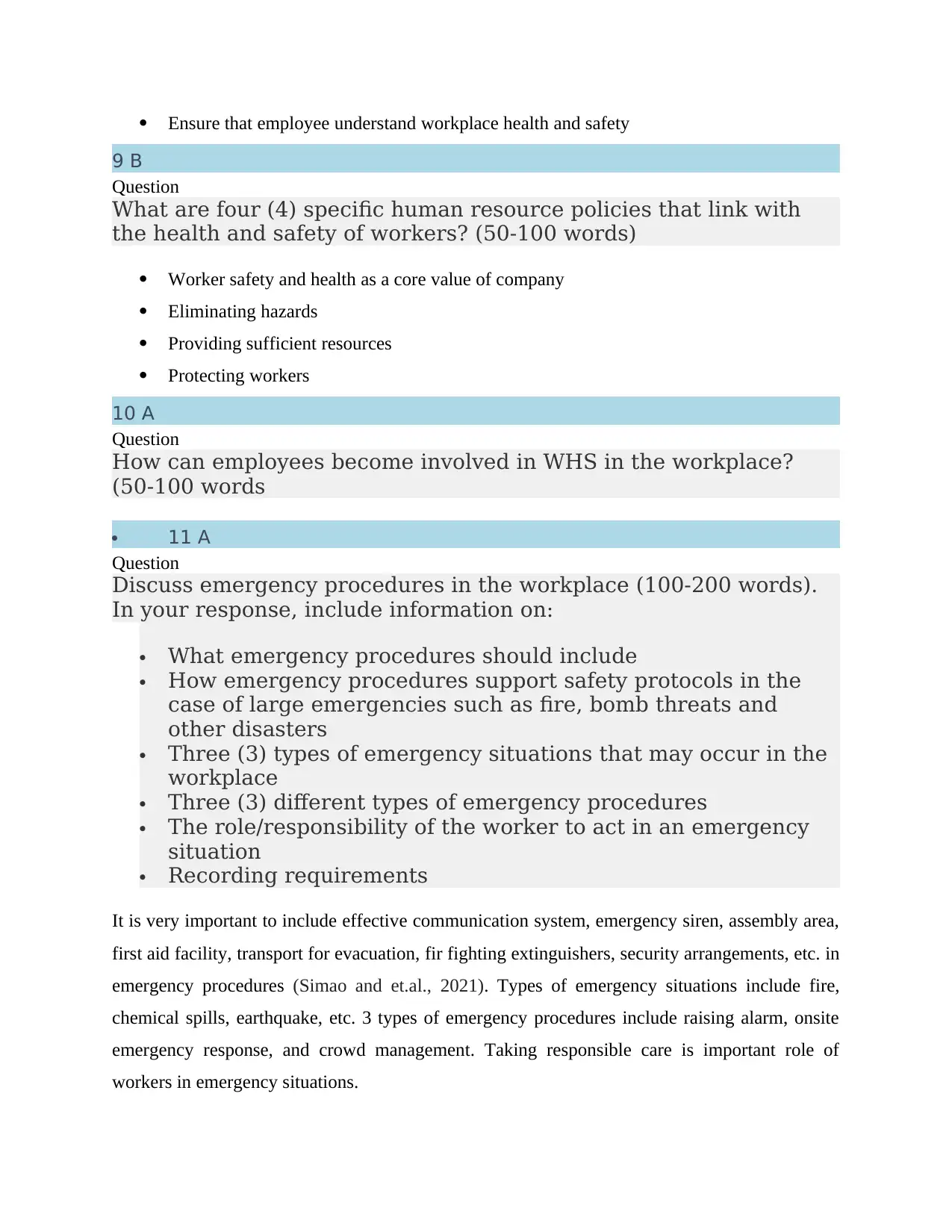
Ensure that employee understand workplace health and safety
9 B
Question
What are four (4) specific human resource policies that link with
the health and safety of workers? (50-100 words)
Worker safety and health as a core value of company
Eliminating hazards
Providing sufficient resources
Protecting workers
10 A
Question
How can employees become involved in WHS in the workplace?
(50-100 words
11 A
Question
Discuss emergency procedures in the workplace (100-200 words).
In your response, include information on:
What emergency procedures should include
How emergency procedures support safety protocols in the
case of large emergencies such as fire, bomb threats and
other disasters
Three (3) types of emergency situations that may occur in the
workplace
Three (3) different types of emergency procedures
The role/responsibility of the worker to act in an emergency
situation
Recording requirements
It is very important to include effective communication system, emergency siren, assembly area,
first aid facility, transport for evacuation, fir fighting extinguishers, security arrangements, etc. in
emergency procedures (Simao and et.al., 2021). Types of emergency situations include fire,
chemical spills, earthquake, etc. 3 types of emergency procedures include raising alarm, onsite
emergency response, and crowd management. Taking responsible care is important role of
workers in emergency situations.
9 B
Question
What are four (4) specific human resource policies that link with
the health and safety of workers? (50-100 words)
Worker safety and health as a core value of company
Eliminating hazards
Providing sufficient resources
Protecting workers
10 A
Question
How can employees become involved in WHS in the workplace?
(50-100 words
11 A
Question
Discuss emergency procedures in the workplace (100-200 words).
In your response, include information on:
What emergency procedures should include
How emergency procedures support safety protocols in the
case of large emergencies such as fire, bomb threats and
other disasters
Three (3) types of emergency situations that may occur in the
workplace
Three (3) different types of emergency procedures
The role/responsibility of the worker to act in an emergency
situation
Recording requirements
It is very important to include effective communication system, emergency siren, assembly area,
first aid facility, transport for evacuation, fir fighting extinguishers, security arrangements, etc. in
emergency procedures (Simao and et.al., 2021). Types of emergency situations include fire,
chemical spills, earthquake, etc. 3 types of emergency procedures include raising alarm, onsite
emergency response, and crowd management. Taking responsible care is important role of
workers in emergency situations.

12 A
Question
Briefly discuss the procedure to be followed in the event of a fire or
an emergency lockdown.
Steps are mentioned below:
Activating fire alarm
Call 911 immediately
Assist injured personnel
Notify for medical emergency
Exit the building
13 A
Question
What are four (4) methods that can be used by a PCBU to provide
support for workers.
Providing safe work environment
Maintain safe systems of work
Provide adequate facilities
Ensure the safe use, handling and storage of plant
14 A
Question
Discuss the role of the HSC in relation to supporting staff and
supporting the organisation’s commitment to work health and
safety. Consider the makeup of the committee, its rights and
responsibilities and how it functions at meetings.
HSC facilitates co-operation in carrying out and developing measures for safety of employees.
14 B
Question
Discuss the role of the HSR
To represent members of a work group in health and safety matters is an important role of HSR
(Alif and et.al., 2020).
15 A
Question
Briefly discuss the procedure to be followed in the event of a fire or
an emergency lockdown.
Steps are mentioned below:
Activating fire alarm
Call 911 immediately
Assist injured personnel
Notify for medical emergency
Exit the building
13 A
Question
What are four (4) methods that can be used by a PCBU to provide
support for workers.
Providing safe work environment
Maintain safe systems of work
Provide adequate facilities
Ensure the safe use, handling and storage of plant
14 A
Question
Discuss the role of the HSC in relation to supporting staff and
supporting the organisation’s commitment to work health and
safety. Consider the makeup of the committee, its rights and
responsibilities and how it functions at meetings.
HSC facilitates co-operation in carrying out and developing measures for safety of employees.
14 B
Question
Discuss the role of the HSR
To represent members of a work group in health and safety matters is an important role of HSR
(Alif and et.al., 2020).
15 A
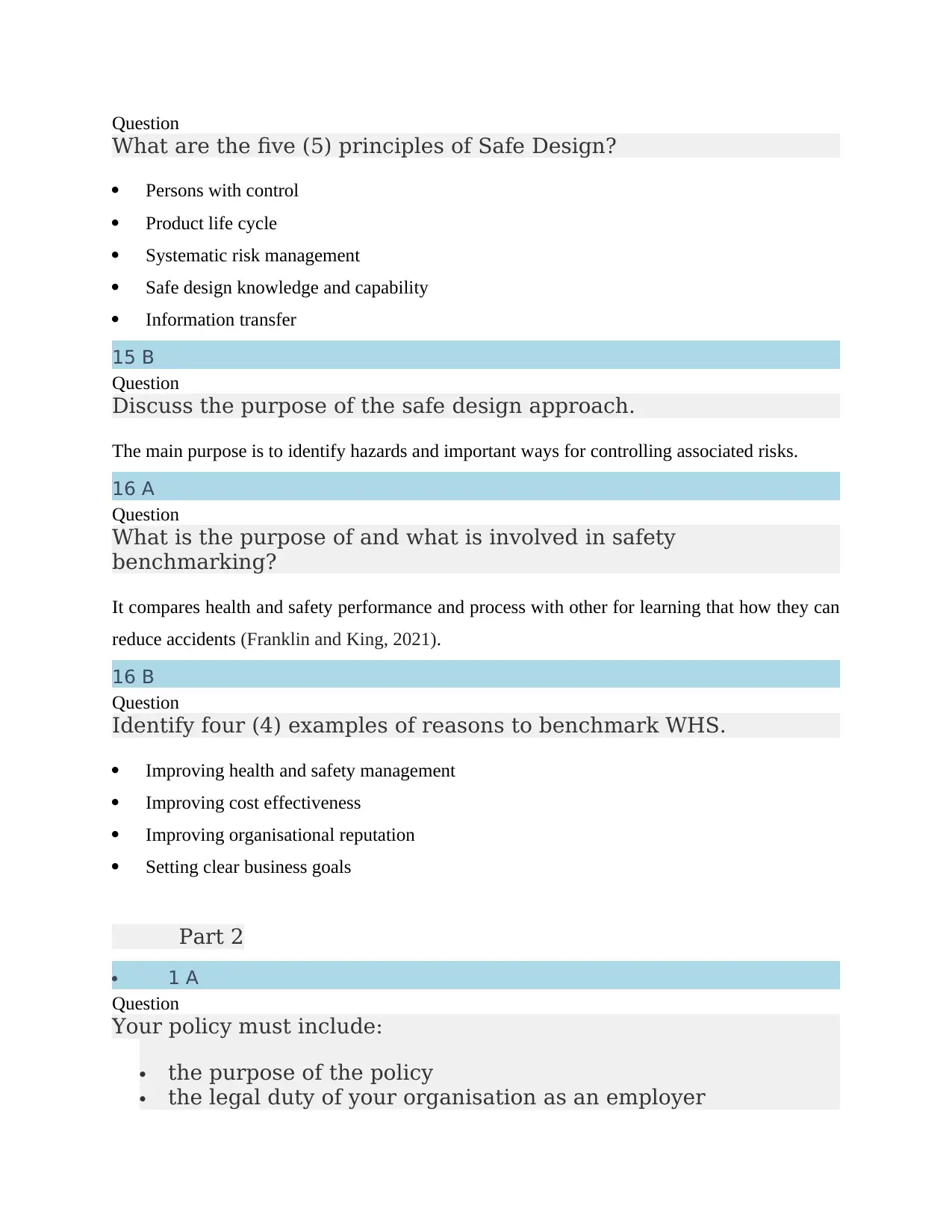
Question
What are the five (5) principles of Safe Design?
Persons with control
Product life cycle
Systematic risk management
Safe design knowledge and capability
Information transfer
15 B
Question
Discuss the purpose of the safe design approach.
The main purpose is to identify hazards and important ways for controlling associated risks.
16 A
Question
What is the purpose of and what is involved in safety
benchmarking?
It compares health and safety performance and process with other for learning that how they can
reduce accidents (Franklin and King, 2021).
16 B
Question
Identify four (4) examples of reasons to benchmark WHS.
Improving health and safety management
Improving cost effectiveness
Improving organisational reputation
Setting clear business goals
Part 2
1 A
Question
Your policy must include:
the purpose of the policy
the legal duty of your organisation as an employer
What are the five (5) principles of Safe Design?
Persons with control
Product life cycle
Systematic risk management
Safe design knowledge and capability
Information transfer
15 B
Question
Discuss the purpose of the safe design approach.
The main purpose is to identify hazards and important ways for controlling associated risks.
16 A
Question
What is the purpose of and what is involved in safety
benchmarking?
It compares health and safety performance and process with other for learning that how they can
reduce accidents (Franklin and King, 2021).
16 B
Question
Identify four (4) examples of reasons to benchmark WHS.
Improving health and safety management
Improving cost effectiveness
Improving organisational reputation
Setting clear business goals
Part 2
1 A
Question
Your policy must include:
the purpose of the policy
the legal duty of your organisation as an employer
Secure Best Marks with AI Grader
Need help grading? Try our AI Grader for instant feedback on your assignments.

your organisation’s commitment to controlling hazards at
their source where practicable, and minimising risks where
possible hazards cannot be eliminated
an outline of how a hazard or issue will be managed –
including resources to be provided
roles and accountabilities of managers and supervisors
a description of how the policy will be communicated to
employees/volunteers and put into practice
Write your procedure to include
Purpose
Legislation
Hazard Control and Minimisation
Emergency procedure:
Risk Management
Standards (safe operation of a lift)
Accountability:
Health and Safety Policy
The main purpose of policy is to ensure the health and safety of all employees in the
organisation.
Company will abide rules and regulation of Safe Work Australia.
For the purpose of controlling and minimization of hazards, company will be making a
commitment that they will use all the possible measures.
There is a planned emergency procedure which follows by company in emergencies
situation.
In order to manage risk, company as investigating the whole plant by regularly.
All the standards are set and for the purpose of maintaining business standard employees
and employers both are taking all measures (Peachey and Lowor, 2020).
For accountability, there is a department which ensure that companies following all the rules
and regulation or not.
their source where practicable, and minimising risks where
possible hazards cannot be eliminated
an outline of how a hazard or issue will be managed –
including resources to be provided
roles and accountabilities of managers and supervisors
a description of how the policy will be communicated to
employees/volunteers and put into practice
Write your procedure to include
Purpose
Legislation
Hazard Control and Minimisation
Emergency procedure:
Risk Management
Standards (safe operation of a lift)
Accountability:
Health and Safety Policy
The main purpose of policy is to ensure the health and safety of all employees in the
organisation.
Company will abide rules and regulation of Safe Work Australia.
For the purpose of controlling and minimization of hazards, company will be making a
commitment that they will use all the possible measures.
There is a planned emergency procedure which follows by company in emergencies
situation.
In order to manage risk, company as investigating the whole plant by regularly.
All the standards are set and for the purpose of maintaining business standard employees
and employers both are taking all measures (Peachey and Lowor, 2020).
For accountability, there is a department which ensure that companies following all the rules
and regulation or not.
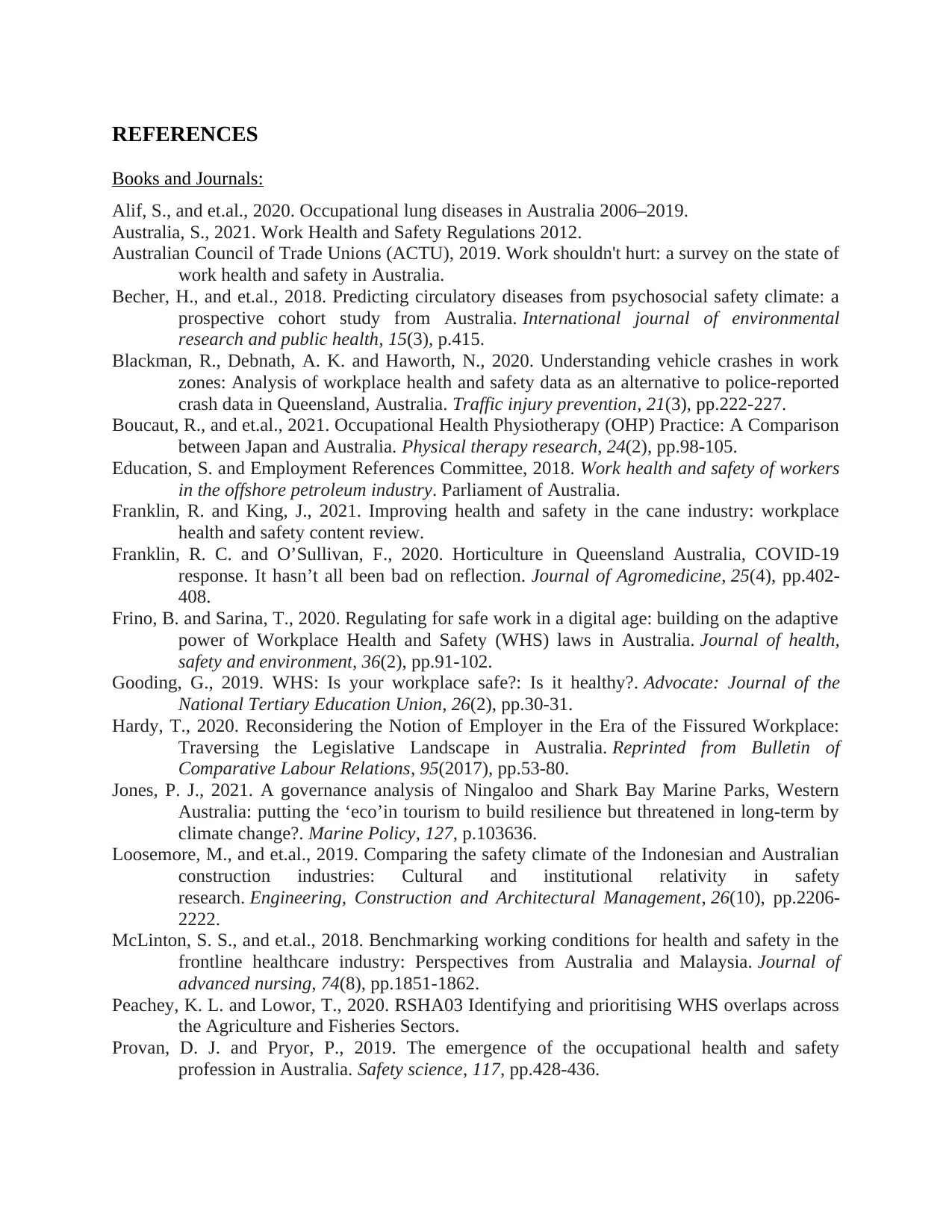
REFERENCES
Books and Journals:
Alif, S., and et.al., 2020. Occupational lung diseases in Australia 2006–2019.
Australia, S., 2021. Work Health and Safety Regulations 2012.
Australian Council of Trade Unions (ACTU), 2019. Work shouldn't hurt: a survey on the state of
work health and safety in Australia.
Becher, H., and et.al., 2018. Predicting circulatory diseases from psychosocial safety climate: a
prospective cohort study from Australia. International journal of environmental
research and public health, 15(3), p.415.
Blackman, R., Debnath, A. K. and Haworth, N., 2020. Understanding vehicle crashes in work
zones: Analysis of workplace health and safety data as an alternative to police-reported
crash data in Queensland, Australia. Traffic injury prevention, 21(3), pp.222-227.
Boucaut, R., and et.al., 2021. Occupational Health Physiotherapy (OHP) Practice: A Comparison
between Japan and Australia. Physical therapy research, 24(2), pp.98-105.
Education, S. and Employment References Committee, 2018. Work health and safety of workers
in the offshore petroleum industry. Parliament of Australia.
Franklin, R. and King, J., 2021. Improving health and safety in the cane industry: workplace
health and safety content review.
Franklin, R. C. and O’Sullivan, F., 2020. Horticulture in Queensland Australia, COVID-19
response. It hasn’t all been bad on reflection. Journal of Agromedicine, 25(4), pp.402-
408.
Frino, B. and Sarina, T., 2020. Regulating for safe work in a digital age: building on the adaptive
power of Workplace Health and Safety (WHS) laws in Australia. Journal of health,
safety and environment, 36(2), pp.91-102.
Gooding, G., 2019. WHS: Is your workplace safe?: Is it healthy?. Advocate: Journal of the
National Tertiary Education Union, 26(2), pp.30-31.
Hardy, T., 2020. Reconsidering the Notion of Employer in the Era of the Fissured Workplace:
Traversing the Legislative Landscape in Australia. Reprinted from Bulletin of
Comparative Labour Relations, 95(2017), pp.53-80.
Jones, P. J., 2021. A governance analysis of Ningaloo and Shark Bay Marine Parks, Western
Australia: putting the ‘eco’in tourism to build resilience but threatened in long-term by
climate change?. Marine Policy, 127, p.103636.
Loosemore, M., and et.al., 2019. Comparing the safety climate of the Indonesian and Australian
construction industries: Cultural and institutional relativity in safety
research. Engineering, Construction and Architectural Management, 26(10), pp.2206-
2222.
McLinton, S. S., and et.al., 2018. Benchmarking working conditions for health and safety in the
frontline healthcare industry: Perspectives from Australia and Malaysia. Journal of
advanced nursing, 74(8), pp.1851-1862.
Peachey, K. L. and Lowor, T., 2020. RSHA03 Identifying and prioritising WHS overlaps across
the Agriculture and Fisheries Sectors.
Provan, D. J. and Pryor, P., 2019. The emergence of the occupational health and safety
profession in Australia. Safety science, 117, pp.428-436.
Books and Journals:
Alif, S., and et.al., 2020. Occupational lung diseases in Australia 2006–2019.
Australia, S., 2021. Work Health and Safety Regulations 2012.
Australian Council of Trade Unions (ACTU), 2019. Work shouldn't hurt: a survey on the state of
work health and safety in Australia.
Becher, H., and et.al., 2018. Predicting circulatory diseases from psychosocial safety climate: a
prospective cohort study from Australia. International journal of environmental
research and public health, 15(3), p.415.
Blackman, R., Debnath, A. K. and Haworth, N., 2020. Understanding vehicle crashes in work
zones: Analysis of workplace health and safety data as an alternative to police-reported
crash data in Queensland, Australia. Traffic injury prevention, 21(3), pp.222-227.
Boucaut, R., and et.al., 2021. Occupational Health Physiotherapy (OHP) Practice: A Comparison
between Japan and Australia. Physical therapy research, 24(2), pp.98-105.
Education, S. and Employment References Committee, 2018. Work health and safety of workers
in the offshore petroleum industry. Parliament of Australia.
Franklin, R. and King, J., 2021. Improving health and safety in the cane industry: workplace
health and safety content review.
Franklin, R. C. and O’Sullivan, F., 2020. Horticulture in Queensland Australia, COVID-19
response. It hasn’t all been bad on reflection. Journal of Agromedicine, 25(4), pp.402-
408.
Frino, B. and Sarina, T., 2020. Regulating for safe work in a digital age: building on the adaptive
power of Workplace Health and Safety (WHS) laws in Australia. Journal of health,
safety and environment, 36(2), pp.91-102.
Gooding, G., 2019. WHS: Is your workplace safe?: Is it healthy?. Advocate: Journal of the
National Tertiary Education Union, 26(2), pp.30-31.
Hardy, T., 2020. Reconsidering the Notion of Employer in the Era of the Fissured Workplace:
Traversing the Legislative Landscape in Australia. Reprinted from Bulletin of
Comparative Labour Relations, 95(2017), pp.53-80.
Jones, P. J., 2021. A governance analysis of Ningaloo and Shark Bay Marine Parks, Western
Australia: putting the ‘eco’in tourism to build resilience but threatened in long-term by
climate change?. Marine Policy, 127, p.103636.
Loosemore, M., and et.al., 2019. Comparing the safety climate of the Indonesian and Australian
construction industries: Cultural and institutional relativity in safety
research. Engineering, Construction and Architectural Management, 26(10), pp.2206-
2222.
McLinton, S. S., and et.al., 2018. Benchmarking working conditions for health and safety in the
frontline healthcare industry: Perspectives from Australia and Malaysia. Journal of
advanced nursing, 74(8), pp.1851-1862.
Peachey, K. L. and Lowor, T., 2020. RSHA03 Identifying and prioritising WHS overlaps across
the Agriculture and Fisheries Sectors.
Provan, D. J. and Pryor, P., 2019. The emergence of the occupational health and safety
profession in Australia. Safety science, 117, pp.428-436.
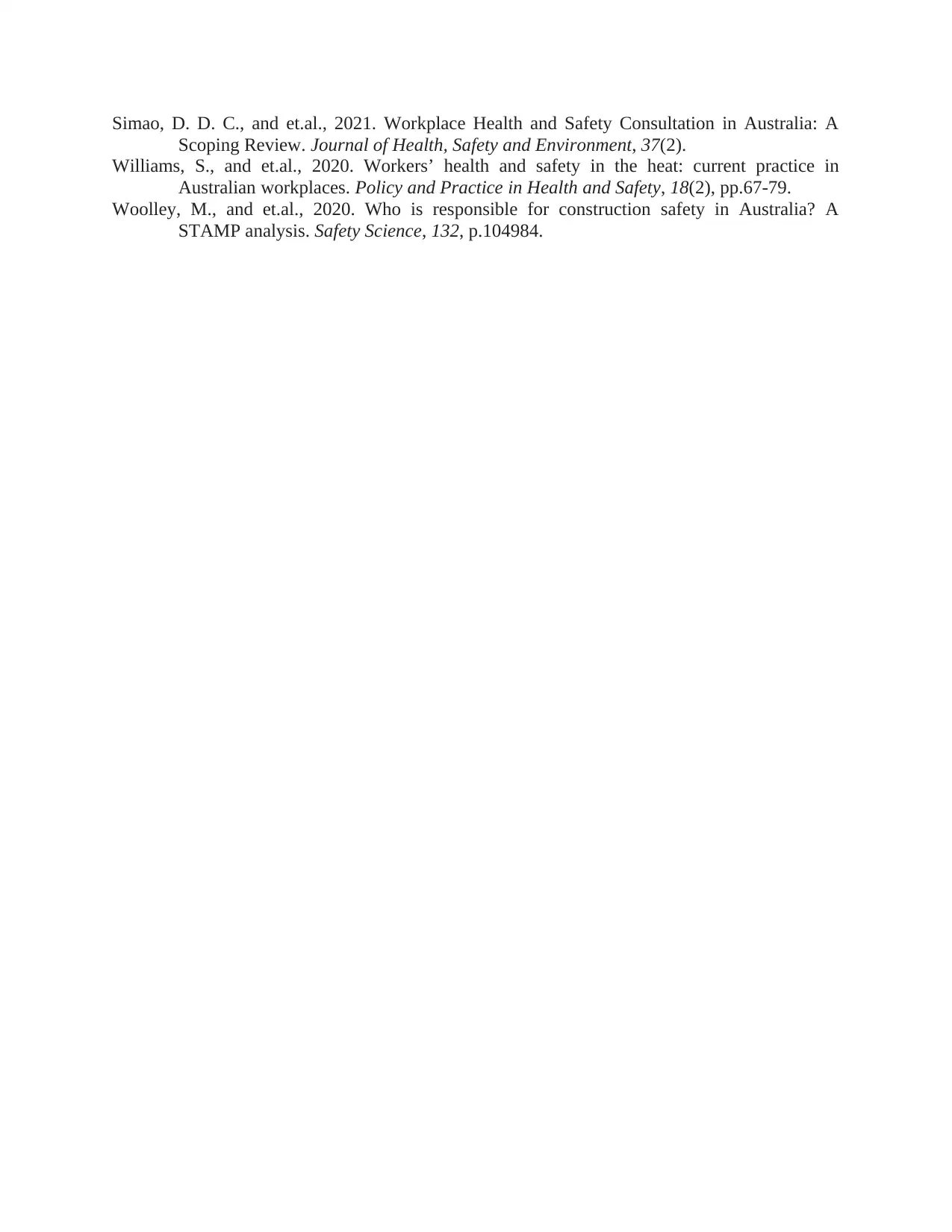
Simao, D. D. C., and et.al., 2021. Workplace Health and Safety Consultation in Australia: A
Scoping Review. Journal of Health, Safety and Environment, 37(2).
Williams, S., and et.al., 2020. Workers’ health and safety in the heat: current practice in
Australian workplaces. Policy and Practice in Health and Safety, 18(2), pp.67-79.
Woolley, M., and et.al., 2020. Who is responsible for construction safety in Australia? A
STAMP analysis. Safety Science, 132, p.104984.
Scoping Review. Journal of Health, Safety and Environment, 37(2).
Williams, S., and et.al., 2020. Workers’ health and safety in the heat: current practice in
Australian workplaces. Policy and Practice in Health and Safety, 18(2), pp.67-79.
Woolley, M., and et.al., 2020. Who is responsible for construction safety in Australia? A
STAMP analysis. Safety Science, 132, p.104984.
1 out of 13
Related Documents
Your All-in-One AI-Powered Toolkit for Academic Success.
+13062052269
info@desklib.com
Available 24*7 on WhatsApp / Email
![[object Object]](/_next/static/media/star-bottom.7253800d.svg)
Unlock your academic potential
© 2024 | Zucol Services PVT LTD | All rights reserved.





